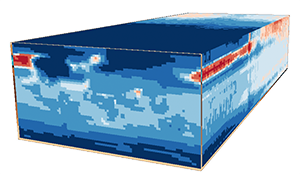R for Earth-System Science

GEOG 4/590: Winter 2024, 2:00-3:50 Tues & Thurs, 121
MCK
Topic: R for Earth-System Science
NOTE: This is the web page for
the Winter 2024 version of the course. Not all pages are populated yet,
but will gradually appear over the next few weeks.
Instructor: Pat Bartlein, bartlein@uoregon.edu, 275 Condon Hall, 6-4967, office
hours directly after class or by appointment.
GE:
Gabriel Abreu-Vigil, Gabreuv6@uoregon.edu, 246 Columbia Hall, office hours
Th. 1pm, 246 Columbia.
Overview: Research in Earth-System Science (ESS) typically involves the analysis and display of large data sets from observations (including reanalysis data sets), satellite and other sources of remote-sensing imagery, or model output. A large array of tools and approaches exists for analyzing those data, and each has its own set of advantages and disadvantages. The R language and data-analysis environment is particularly well suited for analyzing Earth-system data because it includes a large number of analysis packages, many specifically adapted for coping with the characteristics of “big data” like high dimensionality and resolution. In addition, geospatial analyses, that previously required stand-alone GIS programs, are well integrated into R, and R also has the facility for reading, writing and managing netCDF and HDF data sets—the standard way of storing ESS data. This course will review the basic applications of R for data analysis and visualization, the management of large data sets, geospatial analyses, and some representative analyses of ESS data sets. We will also discuss the use of R Markdown and GitHub for doing “reproducible research.”
Course Web Page URL:
https://pjbartlein.github.io/REarthSysSci/